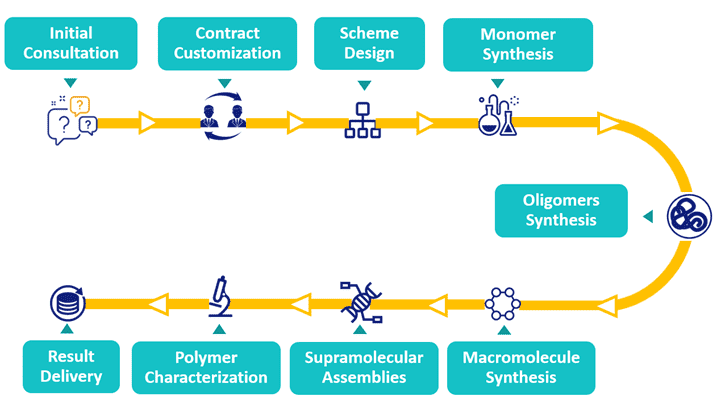Peptide-polymer Conjugates
Peptide-polymer conjugates make up the new class of soft matter comprising natural and synthetic building blocks. Peptide-polymer conjugates take advantage of the special properties of proteins and synthetic polymers to generate hybrid materials with properties yet to be realized with either component alone. BOC Sciences offers high-quality services in peptide-polymer conjugates-related research areas. With our talented scientists and technicians, we have built sophisticated platforms for developing and manufacturing polymer products.
Introduction of Peptide-polymer Conjugates
Peptide-polymer conjugates are a promising class of soft materials, as each component complements the other. Peptides self-assemble into their native structures encoded by primary sequences to support a diverse and complex array of functions. They provide hierarchical self-assembly over multiple length scales, including the molecular level, chemical functionality, selectivity and specificity, and dynamic responses to external stimuli, which are properties of interest for material science. However, the physical limitations of biomolecules, such as their sensitivity to temperature, pH, organic solvents, and degradation, inhibit practical applications. Hence, by combining the hierarchical structures and chemical functionalities of peptides with polymers, which possess stability and processability, peptide-polymer conjugates may potentially lead to the formation of materials with both high complexity and high modularity. In fact, the self-assembly of polypeptide-based block copolymers into micelles and vesicles has been intensively explored, particularly for applications in catalysis and drug delivery.
 Fig. 1. Examples of peptide-polymer conjugates (Annu. Rev. Phys. Chem. 2013, 64: 631-57).
Fig. 1. Examples of peptide-polymer conjugates (Annu. Rev. Phys. Chem. 2013, 64: 631-57).
In contrast to conventional synthetic polymers, peptide sequences can interact with each other via different supramolecular interactions, such as hydrogen bonding and π-π stacking. Peptide-polymer conjugates can form a system capable of responsive hierarchical self-organization over at least three length scales. Most peptide sequences fold into their secondary structures on the smallest length scale, while certain peptides form tertiary structures depending on the sequence. Finally, a microphase separation between the peptide and synthetic polymer offers organization at a larger length scale. This attractive characteristic offers additional opportunities to control the self-assembly of polypeptide-based copolymers and achieve many unique structures. Such hybrid materials may contain novel structures and functions to meet demands in a wide range of biological and nonbiological applications.
Applications of Peptide-polymer Conjugates

- Biomolecular Nanostructures. Engineering amphiphilicity into peptide-polymer conjugates enables them to self-assemble into functional, biomolecular nanostructures, such as spherical micelles, cylindrical micelles, and vesicles, when dissolved in selective solvents.
- Thin Film. Protein-polymer conjugates can be coassembled with synthetic block copolymers to create composites that exhibit hierarchical structural complexity and chemical functionality localized to specific microdomains of the block copolymer thin film.
- Drug/Gene Delivery. Polypeptides such as poly(aspartate), poly(glutamate), and poly(lysine) have been utilized for small-molecule anticancer drugs and gene delivery. In addition, peptide-PEG micelles have also been used for prolonged circulation and controlled drug release.
- Nonbiological Application. Peptide-polymer materials are also capable of impacting nonbiological applications, ranging from gas separation to optoelectronics and catalysis. For instance, peptide-polymer conjugates can generate porous thin films containing subnanometer channels oriented normally to the surface.
Our Services for Peptide-polymer Conjugates
Side-chain Peptide-polymers Preparation
Side-chain functional polymers may be prepared by various (controlled) radical polymerization methodologies. Within this approach, monomers bearing side-groups susceptible to chemoselective reactions are polymerized either in their protected or unprotected form and subsequently reacted with an appropriately functional peptide. BOC Sciences can provide comprehensive custom synthesis services for side-chain functional polymers involving monomers bearing side-group active esters, protected or free ketones and aldehydes, protected maleimides, protected alkynes, azides, and p-aryl halides.
End-group Peptide-polymers Preparation
BOC Sciences can prepare end-group peptide-polymers using various controlled or living polymerization techniques and appropriate functional initiators. These initiators are designed to be inert with respect to the polymerization reaction in their native or protected form, which may be activated following polymerization. Alternatively, the polymerization process may be terminated by a functional terminator, thereby conferring functionality to the end of the polymer.
Assemblies of Peptide-polymer Conjugates
Polypeptides have been frequently used as building blocks to prepare amphiphilic block copolymers. In the past two decades, the self-assembly of polypeptide-based block copolymers into micelles and vesicles has been intensively explored, particularly for catalysis and drug delivery applications. BOC Sciences provides advanced synthetic strategies for the self-assembly of polypeptide-copolymers by utilizing polypeptide molecules, affording unique polypeptide-copolymer structures. Our strategy for self-assembly of peptide-polymer conjugates mainly involves peptide-based coordination of metal ions and spontaneous self-assembly in noncoordinating buffers.
Surface-deposited Peptide-polymer Conjugates
Surface-deposited peptide-polymer conjugates can self-assemble into well-defined nanostructures, forming novel polymers and biomolecules of unique features and bioactivities. BOC Sciences can construct functional surfaces with attractive biological activities, such as antibacterial and cell adhesion properties, by either direct deposition of polymer bioconjugates or stepwise immobilization of polymers and biomolecules on surfaces.
Our Polymer Bioconjugation Workflow

References
- Weil, T. et al. Polymer bioconjugates: Modern design concepts toward precision hybrid materials. Progress in Polymer Science. 2020, 105: 101241.
- Lutz, J.F. et al. Modern trends in polymer bioconjugates design. Prog. Polym. Sci. 2008, 33: 1-39.
- Hest, J.C.M. et al. Polypeptide-polymer bioconjugates. Chem. Soc. Rev. 2010, 39: 329-353.
- Klok, H.A. et al. Peptide/protein–polymer conjugates: synthetic strategies and design concepts. Chem. Commun. 2008, 2591-2611.
- Shu, J.Y. et al. Peptide-Polymer Conjugates: From Fundamental Science to Application. Annu. Rev. Phys. Chem. 2013, 64: 631-57.

 Fig. 1. Examples of peptide-polymer conjugates (Annu. Rev. Phys. Chem. 2013, 64: 631-57).
Fig. 1. Examples of peptide-polymer conjugates (Annu. Rev. Phys. Chem. 2013, 64: 631-57).













